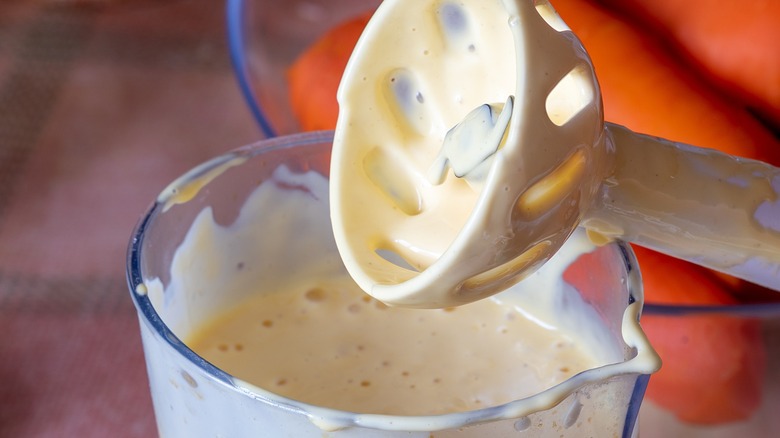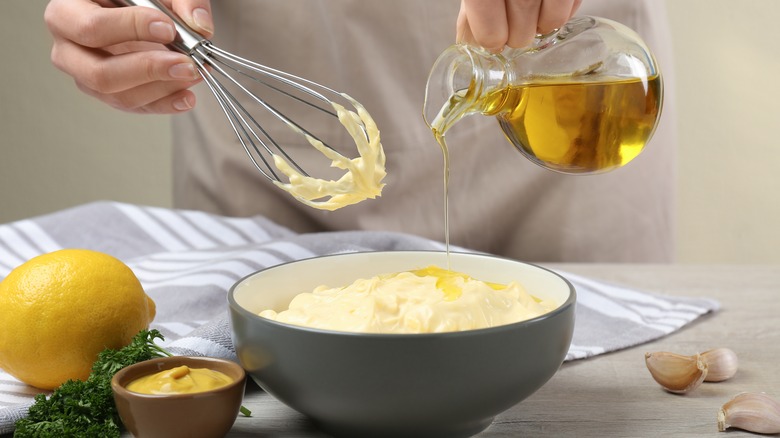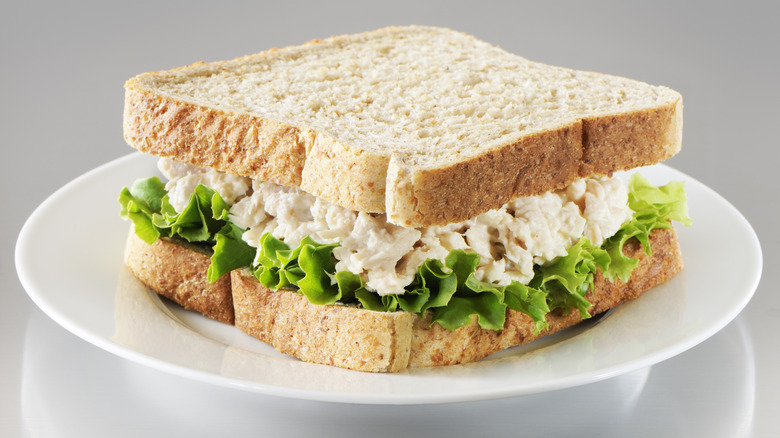Save Frozen Mayo With A Quick Blend
Today's public service announcement: you're not supposed to freeze mayonnaise, as it ruins the texture. Maybe you knew this already, maybe you didn't. But if you end up in the unfortunate position where you have frozen mayo — whether it's because it got shoved to the back of the fridge or someone absentmindedly put the jar in the freezer — there may be a way to save it: blend it.
Mayonnaise is an emulsion. This is a combination of two liquids that don't ordinarily mix — such as water and oil — which are brought together through mixing. It's a delicate balance, and if either ingredient falls out of equilibrium, the emulsion breaks. When water freezes, it swells, and large ice crystals form. The tension of the water no longer holds the oil, which doesn't freeze like water does, and the two separate.
To revive your frozen mayonnaise, it can be blitzed in a blender or food processor. It may work with thawed mayo if you've already taken that step. Adding a little acid — like lemon juice or a touch of vinegar — can help stabilize the emulsion if it's struggling to come back together. If your mayonnaise is still frozen, you can blend it as-is, as chef J. Kenji Lopez-Alt recommended on Twitter. The aggressive action of a blender basically replicates how mayo is made in the first place: water (as the ice melts during blending) and fat are slowly incorporated into each other, rebuilding the emulsion.
It helps to understand how mayo is made
There are many emulsions in the kitchen, such as vinaigrettes or Hollandaise sauce. In these cases, an emulsion is made as tiny droplets of fat become suspended in water by way of a stabilizing agent. Understanding how mayo, an emulsion, is made can help explain how blending frozen mayo may save it. When making mayo, a thin stream of oil is added to egg yolks — the protein is what helps stabilize and emulsify the mixture. As the mixture is whisked or blended, it disperses the oil into the yolks, and an emulsion is made.
The quantity is important: too much water or too much oil will lead to a broken mayo that won't combine. However, a broken mayonnaise can be fixed. If there's too much oil, you can add more of the emulsifier ingredients, which help the emulsion to form. These are egg yolks, some mustard, or lemon juice.
But in the case of frozen mayo, in which the water has released the oil due to a change in phase, it can be brought back together by re-dispersing the oil into tiny droplets. You can do this with the mechanical effort of blending.
Is it safe to eat previously frozen mayo?
According to the United States Department of Agriculture, frozen mayo is not unsafe to eat. But that doesn't mean it's necessarily going to be good. It will take some work to bring this condiment back together, and there's no guarantee that this will happen. Emulsions are notoriously tough to make, or in this case, remake. Even subtle environmental factors like too much humidity can throw your mayo out of whack. But as far as safety goes, yes, it's fine to eat.
Recipes that use mayo that end up frozen are going to be a different story. You're not going to be able to fix the dressing on a pasta salad that got frozen by using this blender hack. Another example that won't reheat well is a frozen casserole with a good amount of mayo in it. Palak Patel, a chef from the Institute of Culinary Education, told Martha Stewart that freezing food that contains mayo changes the consistency. Frozen food with this condiment can become spongey or rubbery in the freezer.


